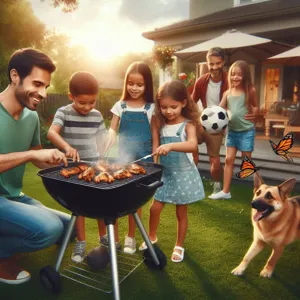As the warm sun beckons and the tantalizing aroma of sizzling meat fills the air, there’s nothing quite like the joy of gathering around the grill for a delicious feast.
Grilling chicken can be a delightful experience, but achieving that perfectly charred, juicy, and flavorful result often eludes even the most enthusiastic backyard chefs. Whether you’re preparing for a summer barbecue, a cozy family dinner, or just a casual weeknight meal, mastering the art of grilling chicken can elevate your culinary skills and impress your guests. In this post, we’ll unveil the top techniques to ensure your chicken turns out perfectly grilled every single time. From marinating and seasoning tips to temperature control and grilling methods, we’ll cover everything you need to know to become a grill master and create mouthwatering chicken dishes that will have everyone coming back for seconds. Get ready to fire up the grill and embark on a flavorful journey that will transform your cooking game!
1. Understanding Different Cuts of Chicken

When it comes to grilling chicken, understanding the various cuts and their unique characteristics is essential for achieving perfectly cooked results every time. Each cut of chicken brings its own flavor profile, texture, and cooking requirements, making it crucial to choose the right one for your grilling adventure.
**Chicken Breasts**: Often the go-to cut for many grill enthusiasts, chicken breasts are lean and cook relatively quickly. They can be boneless or bone-in, with the latter providing a bit more flavor and moisture. However, because they are so lean, they can easily dry out if overcooked. To combat this, consider marinating them beforehand or using techniques like brining to infuse moisture and flavor.
**Chicken Thighs**: For those who prefer a richer taste, chicken thighs are a perfect option. Dark meat is juicier than white meat due to its higher fat content, which makes it more forgiving on the grill. Thighs can be purchased boneless or bone-in, and they benefit from longer cooking times, allowing the fat to render out and the meat to become tender and flavorful.
**Drumsticks**: Another popular choice, drumsticks offer a fun, hands-on eating experience. They are also relatively inexpensive and packed with flavor. When grilling drumsticks, it’s best to cook them at a lower temperature initially to ensure that they cook through without burning on the outside. Once they’re nearly done, a quick sear over higher heat can create a deliciously crispy skin.
**Whole Chicken**: For the ultimate grilling experience, consider roasting a whole chicken on the grill. This method allows you to infuse flavors throughout the entire bird. Spatchcocking (removing the backbone) can help the chicken cook more evenly and reduce cooking time. With the right seasoning and a good grill setup, you can achieve crispy skin and succulent meat that will impress family and friends alike.
By understanding the different cuts of chicken and their specific grilling needs, you can tailor your cooking techniques to ensure each piece is flavorful, juicy, and perfectly grilled. Whether you choose tender breasts, flavorful thighs, or delightful drumsticks, knowing how to handle each cut will elevate your grilling game and ensure a delicious outcome every time.
2. Marinating: The Key to Flavorful Chicken
Marinating is the secret sauce to unlocking a world of flavor in your grilled chicken, transforming a simple piece of meat into a succulent masterpiece. The process of marination involves soaking your chicken in a mixture of acidic ingredients, oils, and seasonings, allowing it to absorb layers of taste and tenderness. The right marinade not only infuses flavor but also helps to break down the proteins in the chicken, resulting in a juicier and more tender bite.
To create a standout marinade, start with an acid base—think yogurt, vinegar, or citrus juice. These ingredients not only contribute tanginess but also help to tenderize the meat. Next, add a good-quality oil, such as olive oil or sesame oil, which acts as a carrier for the flavors and aids in the cooking process. Then, it’s time to get creative with your seasonings! fresh herbs like rosemary or thyme, spices like paprika or cumin, garlic, ginger, and even a touch of honey or brown sugar can elevate your marinade to new heights.
Once your marinade is ready, immerse the chicken, ensuring every crevice is coated. For optimal results, let it marinate for at least 30 minutes, but longer is often better—aim for four hours or even overnight for maximum flavor penetration. Keep in mind the type of chicken you’re working with; bone-in pieces may require more time than boneless cuts.
When it’s time to grill, remove the chicken from the marinade, allowing any excess liquid to drip off. This step is crucial to avoid flare-ups on the grill. As you place the chicken on the grill, you’ll immediately notice the enticing aroma of the marinated meat cooking, promising a flavor explosion with every bite.
By mastering the art of marinating, you not only ensure that your grilled chicken is bursting with flavor but also impress your guests with your culinary prowess. So gather your ingredients, unleash your creativity, and watch as simple chicken transforms into a flavorful delight that keeps everyone coming back for more!
3. The Importance of Temperature Control

When it comes to grilling chicken, mastering temperature control is the secret ingredient that can make or break your culinary masterpiece. Chicken is notoriously tricky; its lean meat can easily go from succulent to dry in a matter of moments if not cooked at the right temperature. This is why understanding and managing the heat of your grill is crucial.
first, let’s talk about preheating. Before you even place your chicken on the grill, it’s essential to preheat it to a steady, medium-high temperature, usually around 375°F to 450°F. This initial heat sears the surface of the chicken, locking in moisture and creating that coveted crispy skin. Use a grill thermometer to ensure accuracy; an improperly heated grill can lead to uneven cooking and undesirable textures.
Once your chicken is on the grill, it’s important to monitor the temperature of the chicken itself. The USDA recommends cooking chicken to an internal temperature of 165°F. Using a meat thermometer can help you achieve this without guesswork. Insert the thermometer into the thickest part of the chicken, avoiding the bone, to get an accurate reading.
Additionally, consider the concept of direct and indirect heat. For thicker cuts, such as bone-in breasts or whole chickens, start by searing them over direct heat to create those grill marks and then move them to a cooler part of the grill to finish cooking through indirect heat. This dual-zone cooking method allows you to control the temperature more effectively and prevents the outside from burning while the inside remains undercooked.
Lastly, don’t forget to let your chicken rest after grilling! Allowing it to sit for a few minutes will enable the juices to redistribute, resulting in a more flavorful and tender piece of meat. Mastering temperature control gives you the power to serve perfectly grilled chicken every time, impressing your friends and family with your grilling prowess. So fire up that grill, keep an eye on the heat, and get ready to savor the delicious results!
4. Preparing the Grill: Charcoal vs. Gas
When it comes to grilling chicken to perfection, one of the most crucial steps lies in the preparation of your grill. The choice between charcoal and gas can significantly influence the flavor, texture, and overall outcome of your meal. Each method has its unique advantages, and understanding these can help you make an informed decision that aligns with your grilling style.
**Charcoal Grilling**: For many aficionados, charcoal grilling is the gold standard. The unmistakable smoky flavor imparted by burning charcoal is difficult to replicate. When using a charcoal grill, start by arranging the charcoal into a mound and lighting it until the coals are covered with a light ash—this usually takes about 15-20 minutes. Once they’re glowing hot, spread them out evenly for direct grilling, or bank them to one side for indirect cooking. The key here is to control the heat: have a hot zone for searing and a cooler zone for cooking through. Don’t forget to add wood chips for an extra layer of flavor; hickory or applewood can elevate your chicken to new heights.
**Gas Grilling**: On the other hand, gas grills offer convenience and precision. With the simple turn of a knob, you can adjust the heat to your preferred level, making it easier to maintain a consistent temperature throughout the cooking process. Preheat your gas grill by lighting it and letting it reach the desired temperature before placing your chicken on the grates. The even heat distribution allows for perfect cooking without the need for constant monitoring. While gas grills may not impart the same smoky flavor as their charcoal counterparts, experimenting with smoker boxes filled with wood chips can introduce that beloved smokiness to your chicken.
Ultimately, the choice between charcoal and gas comes down to personal preference, convenience, and the flavors you desire. Whether you opt for the traditional charm of charcoal or the modern ease of gas, mastering the grill comes down to understanding how to prepare your cooking surface, ensuring your chicken turns out juicy and flavorful every time. So fire up those grills, and get ready to impress your taste buds!
5. Essential Tools for Grilling Chicken

When it comes to grilling chicken to perfection, having the right tools at your disposal can make all the difference between a lackluster meal and a mouthwatering masterpiece. Here’s a rundown of essential tools that every grilling enthusiast should consider for achieving juicy, flavorful chicken every time.
**1. Grill Thermometer:** Ensuring your chicken is cooked to the perfect internal temperature is crucial for both safety and flavor. A reliable grill thermometer takes the guesswork out of cooking. Opt for a digital instant-read thermometer for quick results, allowing you to check the doneness without losing valuable heat from the grill.
**2. Long-Handled Tongs:** When it comes to flipping and turning your chicken, a sturdy pair of long-handled tongs is indispensable. These allow you to maneuver chicken pieces easily while keeping your hands at a safe distance from the heat. Look for tongs with a good grip and a locking mechanism for easy storage.
**3. Grill Basket:** For those times when you’re grilling smaller cuts of chicken or marinated pieces that may fall through the grates, a grill basket is a lifesaver. These baskets provide a secure place for your chicken, allowing for even cooking and easy flipping without the fear of losing your dinner to the flames.
**4. Basting Brush:** To enhance the flavor of your grilled chicken, a basting brush is essential for applying marinades, sauces, or oils. Opt for a silicone brush that can withstand high temperatures and is easy to clean. Basting your chicken periodically keeps it moist and infuses it with layers of flavor.
**5. Aluminum Foil:** While it might not seem like a tool, aluminum foil is your friend when it comes to grilling chicken. Use it to create foil packets for marinated chicken or to cover the grill for indirect cooking. Foil can also be used to wrap leftover grilled chicken, preserving its moisture and flavor for future meals.
**6. Grill Brush:** Maintaining your grill is just as important as cooking on it. A grill brush will help you keep your grates clean and free from burnt residue, which can affect the taste of your chicken. Choose a sturdy brush with stainless steel bristles for durability and effectiveness.
By equipping yourself with these essential grilling tools, you’ll be well on your way to mastering the grill and serving perfectly grilled chicken that will impress family and friends alike. Each tool serves its purpose, ensuring that your grilling experience is not only enjoyable but also yields delicious results every time. Happy grilling!
6. The Art of Seasoning: Herbs and Spices to Use
When it comes to grilling chicken, the secret to achieving that mouthwatering flavor lies in the art of seasoning. A well-seasoned piece of chicken can elevate your dish from ordinary to extraordinary, transforming a simple meal into a culinary delight. The key is to strike a balance between enhancing the natural flavors of the chicken and introducing bold notes that tantalize the taste buds.
**Herbs:** Fresh herbs are a grill master’s best friend. Consider using classic staples like rosemary and thyme, which add an earthy depth to grilled chicken. For a brighter taste, sprinkle some fresh parsley or basil just before serving. A marinade that includes cilantro can also lend a refreshing twist, especially when paired with lime juice for a zesty kick. Don’t shy away from experimenting with herbs like tarragon or dill for a unique flavor profile that surprises and delights.
**Spices:** The world of spices opens up a realm of possibilities. Paprika, whether sweet or smoked, provides a warm, rich flavor and a beautiful color to your chicken. Cumin and coriander bring a subtle earthiness, while a pinch of cayenne can add just the right amount of heat for those who enjoy a bit of spice. For a more adventurous palate, try a blend of garam masala or za’atar to transport your taste buds on a flavor journey.
**Marinades and Rubs:** Combining herbs and spices into a marinade or rub can create a flavor-packed experience. A simple mixture of olive oil, lemon juice, garlic, and your choice of herbs can work wonders. Let your chicken soak in this blend for at least 30 minutes—or even overnight—to ensure the flavors penetrate the meat deeply. Alternatively, a dry rub made with your favorite spices can also create a beautifully caramelized crust on the grill, sealing in moisture while imparting rich flavor.
Remember, the art of seasoning is all about personal preference. Don’t be afraid to taste as you go and adjust according to your liking. With the right herbs and spices, you’ll unlock a world of flavor that will keep your guests coming back for more. So grab your favorite seasonings, unleash your creativity, and get ready to grill chicken that’s not just cooked, but perfectly seasoned and bursting with flavor!
7. Techniques for Even Cooking: Direct vs. Indirect Heat

When it comes to grilling chicken to perfection, understanding the difference between direct and indirect heat is crucial for achieving that coveted juicy, evenly cooked result. Both techniques serve distinct purposes, and mastering them can elevate your grilling game to new heights.
**Direct heat** is your go-to method for quick cooking and achieving those beautiful grill marks. This technique involves placing the chicken directly over the heat source, whether it’s charcoal or gas flames. Ideal for thinner cuts, like chicken breasts or wings, direct heat allows for a sear that locks in moisture and flavor. To utilize this method effectively, preheat your grill to a high temperature, then place the chicken on the grates for a few minutes on each side. Keep a close eye on it, as cooking times can vary based on the thickness of the pieces. The result? A tantalizingly charred exterior that contrasts beautifully with the tender, juicy meat inside.
On the other hand, **indirect heat** is your secret weapon for larger cuts, such as whole chickens or bone-in thighs. This method involves placing the chicken away from the direct flames, allowing it to cook slowly in a more controlled environment. To set up your grill for indirect heat, simply light one side and leave the other side off, creating a two-zone cooking area. This technique is perfect for ensuring that the chicken cooks evenly without burning the outside. Cover the grill to trap heat and smoke, resulting in a deliciously cooked bird that’s tender and infused with flavor. The key here is patience; slow cooking allows the interior to reach the desired temperature without compromising the exterior.
Combining these two techniques can also yield fantastic results. Start by searing the chicken over direct heat to develop a flavorful crust, and then move it to the cooler side of the grill for gentle cooking. This dual approach not only enhances the flavor but also ensures that your chicken is perfectly cooked through, eliminating the risk of dry, overcooked meat.
By skillfully employing direct and indirect heat, you can become a grill master, ensuring that every chicken dish you serve is nothing short of extraordinary. Whether you’re cooking up a casual backyard barbecue or an elegant dinner, understanding these techniques will make all the difference in delivering perfectly grilled chicken every time.
8. Using a Meat Thermometer for Perfect Doneness
When it comes to grilling chicken, achieving the perfect doneness can be a daunting task, but a meat thermometer is your ultimate ally in this culinary quest. Gone are the days of slicing into your chicken to check for that elusive, juicy pinkness at the bone, which can lead to dry, overcooked meat or, worse yet, undercooked poultry. Investing in a quality meat thermometer takes the guesswork out of grilling, ensuring that your chicken is cooked to perfection every single time.
To use a meat thermometer effectively, insert the probe into the thickest part of the chicken, avoiding the bone, which can give you an inaccurate reading. For chicken breasts, you’re aiming for an internal temperature of 165°F (74°C), while thighs can be safely enjoyed at 175°F (80°C). As the chicken cooks, monitor the temperature closely. As it approaches the target, reduce your grill’s heat, allowing for a gentle finish that locks in moisture and flavor.
Not only does using a meat thermometer help you achieve the ideal doneness, but it also grants you the confidence to experiment with different marinades and grilling techniques. Whether you’re going for a smoky barbecue glaze or a light herb-infused rub, knowing that your chicken is cooked accurately frees you to focus on the flavors and presentation.
Once your chicken reaches the desired temperature, remember to let it rest for a few minutes before slicing. This crucial step allows the juices to redistribute, resulting in tender, flavorful meat. So, grab that meat thermometer, and take your chicken grilling game to the next level—your taste buds will thank you!
9. Tips for Achieving Perfect Grill Marks
Achieving those coveted grill marks on your chicken is not just a matter of aesthetics; it’s a badge of honor that signifies a perfectly grilled piece of meat. Grill marks not only enhance the visual appeal of your dish but also contribute to the overall flavor by creating delicious caramelization on the surface. Here are some essential tips to ensure you achieve those iconic crosshatch patterns on your chicken every time.
**Preheat Your Grill:** The first step to perfect grill marks is to ensure your grill is hot enough. Preheat your grill to a high temperature, ideally around 400°F to 450°F. A properly heated grill will sear the chicken quickly, locking in moisture and flavor while creating those distinctive lines.
**Oil Your Grates:** To prevent sticking and ensure clean grill marks, oil your grates before placing your chicken on them. Use a paper towel dipped in vegetable oil and carefully wipe the grates, or use a grill-safe spray. This not only helps with the marks but also contributes to an even sear.
**Positioning is Key:** When placing your chicken on the grill, be deliberate with your positioning. For classic grill marks, set the chicken down at a 45-degree angle to the grates. After a few minutes, rotate the chicken 90 degrees without flipping it over. This technique will create the beautiful crosshatch pattern that makes grilled chicken look professionally done.
**Timing and Patience:** Don’t rush the process. Allow the chicken to sear undisturbed for about 4-5 minutes on each side, depending on the thickness. This waiting period is crucial for developing those grill marks—flipping too soon can lead to sticking and uneven marks.
**Flip with Care:** When it’s time to flip your chicken, use tongs instead of a fork, which can pierce the meat and release valuable juices. Gently lift the chicken and turn it over, ensuring you don’t disrupt the sear you’ve already created.
**Finishing Touches:** Once your chicken is cooked through and has those beautiful grill marks, consider adding a final touch. A light brush of marinade or glaze during the last few minutes on the grill can enhance both flavor and appearance, leaving you with a beautifully charred and enticing dish.
By following these tips, you’ll not only impress your guests with the visual appeal of your grilled chicken but also elevate its flavor, making each bite a true delight. Mastering the art of grill marks is just one step on your journey to becoming a grilling aficionado!
10. Resting the Chicken: Why It Matters
Resting the chicken after grilling is a crucial step that many home cooks overlook, but it can make all the difference in achieving perfectly juicy and flavorful results. When chicken is cooked, the proteins contract and the juices are pushed towards the center of the meat. If you cut into it immediately after grilling, all those delightful juices will escape, leaving you with a dry and less satisfying dish.
Allowing the chicken to rest for at least 5 to 10 minutes after it comes off the grill gives the juices time to redistribute throughout the meat. This resting period helps ensure that each bite is succulent and moist. The residual heat continues to cook the chicken slightly, bringing it to the optimal temperature without overcooking.
To rest your chicken properly, transfer it from the grill to a cutting board and loosely cover it with aluminum foil. This maintains warmth while allowing steam to escape, preventing the skin from becoming soggy. During this time, you can prepare any side dishes or sauces, making it a perfect moment to add the finishing touches to your meal.
Remember, patience is key. The few extra minutes you take to let your chicken rest will be rewarded with tender, juicy meat that’s bursting with flavor, making every bite a delightful experience. So, resist the urge to dive in too quickly—your taste buds will thank you!
11. Creative Sauce and Glaze Ideas
When it comes to grilling chicken, the sauce or glaze can elevate the dish from ordinary to extraordinary. The right combination of flavors not only enhances the natural juiciness of the chicken but also adds a delightful complexity that keeps taste buds tingling. Here are some creative sauce and glaze ideas that will make your grilled chicken the star of any BBQ.
**1. Zesty Citrus Marinade:** Combine fresh orange juice, lime juice, minced garlic, and a splash of olive oil for a bright, refreshing marinade. The acidity from the citrus not only tenderizes the chicken but also infuses it with a vibrant flavor. Let it marinate for at least an hour, and you’ll have a dish that bursts with sunshine in every bite.
**2. Smoky BBQ Honey Glaze:** Mix your favorite barbecue sauce with honey and a dash of smoked paprika for a sticky, sweet glaze that caramelizes beautifully on the grill. This combo allows the sugars to caramelize, forming a glossy finish that adds depth to your grilled chicken, making it irresistible.
**3. Spicy Sriracha and Lime:** For those who crave heat, a mixture of sriracha, lime juice, and a hint of brown sugar creates a fiery glaze that packs a punch. Brush it on during the last few minutes of grilling to achieve a sticky, spicy coating that will have your guests reaching for seconds.
**4. Herbed Yogurt Sauce:** For a refreshing twist, consider a herbed yogurt sauce made from Greek yogurt, fresh dill, mint, and a squeeze of lemon. This cooling sauce is perfect for grilled chicken, balancing the smoky flavors with its creamy texture and zesty notes.
**5. Teriyaki Soy Glaze:** Combine soy sauce, mirin, brown sugar, and sesame oil for a classic teriyaki glaze. Brush this on your chicken during the last few minutes of grilling for a sticky, savory finish that’s reminiscent of your favorite Asian takeout.
**6. Pineapple Salsa:** For a fruity flair, try a fresh pineapple salsa made with diced pineapple, red onion, cilantro, and jalapeño. This vibrant topping adds a refreshing crunch and a sweet-and-spicy kick that pairs perfectly with grilled chicken.
Experimenting with these sauces and glazes not only enhances flavor but also allows you to customize your chicken to suit various palates. Whether you prefer something tangy, sweet, spicy, or fresh, these creative ideas will help you master the grill and serve up perfectly grilled chicken every time. So fire up that grill, get creative, and let your culinary imagination run wild!
12. Troubleshooting Common Grilling Issues
Grilling chicken can be a delightful experience, but even the most seasoned grillers encounter challenges along the way. Troubleshooting common grilling issues is essential to ensure your chicken turns out perfectly every time. Here are some common problems and their solutions to keep your grilling game strong.
**1. Uneven Cooking:** If you find that some pieces of chicken are undercooked while others are overdone, it may be due to uneven heat distribution on your grill. To combat this, invest in a good quality grill thermometer to monitor the temperature accurately. Additionally, consider using the two-zone grilling method—create a hot side for searing and a cooler side for gentle cooking. This way, you can start with high heat to get those beautiful grill marks and then move the chicken to the cooler side to finish cooking without burning.
**2. Sticking to the Grill:** There’s nothing more frustrating than when your chicken skin sticks to the grill grates, tearing apart your beautifully marinated pieces. To prevent this, ensure your grill is preheated and properly oiled. Use a paper towel dipped in cooking oil and carefully wipe down the grates just before placing the chicken on them. This simple step creates a non-stick surface that allows for easy flipping and removal.
**3. Dry or Overcooked Chicken:** Achieving juicy and flavorful chicken can sometimes feel like a balancing act. If your chicken tends to come out dry, it may be due to cooking it at too high a temperature or for too long. Always aim for an internal temperature of 165°F (75°C) and use a meat thermometer to check. Additionally, consider brining your chicken beforehand or marinating it for a few hours. This infuses moisture and flavor, ensuring your chicken stays succulent even when cooked over high heat.
**4. Flavorless Chicken:** If your grilled chicken lacks flavor, it’s time to rethink your seasoning strategy. Don’t skimp on the marinade or rub! A good marinade should have a balance of acidity (like lemon juice or vinegar), oil, and plenty of spices. Allow your chicken to marinate for at least 30 minutes, but ideally, a few hours or overnight for maximum flavor infusion. For an extra kick, consider adding a dry rub right before grilling to enhance the exterior flavor.
**5. Burnt Outside, Raw Inside:** This common issue often arises from cooking chicken over flames that are too high. To avoid this, use indirect heat to cook your chicken through while still achieving a gorgeous char. Start by searing the chicken on direct heat for a few minutes on each side, then move it to the cooler side of the grill to finish cooking. This method allows the internal temperature to rise without burning the exterior.
By keeping these troubleshooting tips in mind, you can tackle common grilling issues head-on, ensuring that your chicken not only looks great but also tastes divine. Mastering these techniques will elevate your grilling skills, making every barbecue event a resounding success!
13. Pairing Sides and Drinks with Grilled Chicken
When it comes to mastering the grill, the chicken may take center stage, but the sides and drinks you choose can elevate your meal from ordinary to extraordinary. Pairing your perfectly grilled chicken with the right accompaniments not only enhances the overall flavor profile but also creates a well-rounded dining experience that will leave your guests raving.
**Sides that Sing:** Think about the textures and flavors that will complement your grilled chicken. A light and refreshing coleslaw can provide a crunchy contrast, while a creamy potato salad offers a rich comfort. Grilled vegetables, such as bell peppers, zucchini, and asparagus, bring vibrant colors and earthy flavors to your plate. Consider adding a zesty corn salad with lime and cilantro to bring a burst of freshness. For a more indulgent option, a creamy mac and cheese or buttery garlic bread can satisfy those craving something hearty.
**The Perfect Drink:** Don’t forget about beverages! The right drink can enhance the enjoyment of your meal. A crisp, chilled white wine like Sauvignon Blanc or a light red like Pinot Noir can beautifully complement the flavors of your grilled chicken, especially if you’ve marinated it with herbs or citrus. If you’re catering to a non-alcoholic crowd, consider refreshing iced teas or lemonades, perhaps infused with herbs like mint or basil to add an extra layer of flavor. For something fun, craft cocktails featuring fresh fruits or herbs can add a festive touch to your gathering.
**Balancing Act:** Remember, the key to a great meal is balance. If your grilled chicken has a spicy kick, consider serving it with cooling sides and refreshing drinks. Conversely, if your chicken is lightly seasoned, don’t shy away from bold, flavorful sides that can stand up to it. By thoughtfully pairing your sides and drinks with grilled chicken, you’ll create a harmonious meal that celebrates the art of grilling while tantalizing the taste buds of everyone at your table. Whether it’s a casual backyard barbecue or an elegant dinner party, these pairings will ensure your grilled chicken shines in the best possible light.
14. Cleaning and Maintaining Your Grill
Cleaning and maintaining your grill is an essential step that often gets overlooked amidst the excitement of cooking up a delicious meal. A well-maintained grill not only ensures better flavor and cooking performance but also extends the life of your grilling equipment. To start, make it a habit to clean your grill grates after every use. While the grill is still warm, use a stiff wire brush to scrub away any food residue or charred bits. For stubborn grime, a mixture of vinegar and baking soda works wonders—spray it on, let it sit for a few minutes, and then scrub away.
Don’t forget about the grease trap! Over time, grease can build up and create a fire hazard, so regularly check, empty, and clean it out to prevent flare-ups. For gas grills, inspect the burners and hoses for any clogs or leaks at the start of each grilling season. A simple soap and water solution can reveal any leaks; just apply it to the hoses and look for bubbles forming.
For charcoal grills, ensure that you remove leftover ash after each use. Ash can trap moisture, leading to rust and deterioration, so a quick cleanup will help keep your grill in prime condition. Additionally, every few months, consider giving your grill a deeper clean by disassembling components and washing them with warm, soapy water.
Finally, protect your investment by using a grill cover when it’s not in use. This simple step will shield your grill from the elements, preventing rust and fading while keeping it ready for your next barbecue. With consistent care and maintenance, you’ll ensure that your grill performs at its best, allowing you to master the art of grilling perfectly succulent chicken, time after time.
15. Experimenting with Different Grilling Methods: Smoking and Rotisserie
When it comes to grilling chicken, there’s a world of flavors waiting to be explored beyond the traditional direct heat method. Two techniques that can elevate your poultry game to new heights are smoking and rotisserie cooking. Both methods offer unique benefits, infusing your chicken with tantalizing flavors and creating a succulent texture that’s hard to resist.
**Smoking** is a technique that allows you to impart a rich, deep flavor through the slow infusion of wood smoke. Whether you choose hickory, applewood, or mesquite, each type of wood brings its own signature taste. To get started, you’ll want to use a dedicated smoker or a grill set up for indirect heat. Soak your wood chips in water for about 30 minutes and then add them to the heat source. The key is to maintain a low temperature, usually between 225°F to 250°F, allowing the chicken to cook slowly and absorb those smoky notes. This method is perfect for bone-in pieces like thighs and drumsticks, which benefit from the extended cooking time, resulting in tender, juicy meat with a delightful crust.
On the other hand, **rotisserie grilling** offers a mesmerizing way to cook chicken evenly while keeping it moist. This method involves skewering the chicken on a rotisserie spit, which rotates over the heat source. The constant rotation ensures that the chicken cooks uniformly, and the skin gets beautifully crispy while the meat remains juicy. If you have a gas or charcoal grill with a rotisserie attachment, this method is worth trying. To enhance the flavor, consider marinating your chicken beforehand or seasoning it generously with your favorite rub. The slow, even cooking allows the fat to render down, basting the chicken as it spins, creating a mouthwatering dish that’s perfect for impressing guests at your next barbecue.
By experimenting with these alternative grilling methods, you not only expand your culinary repertoire but also delight your taste buds with an array of flavors and textures. So fire up your grill and let your creativity soar—your perfectly grilled chicken awaits!






